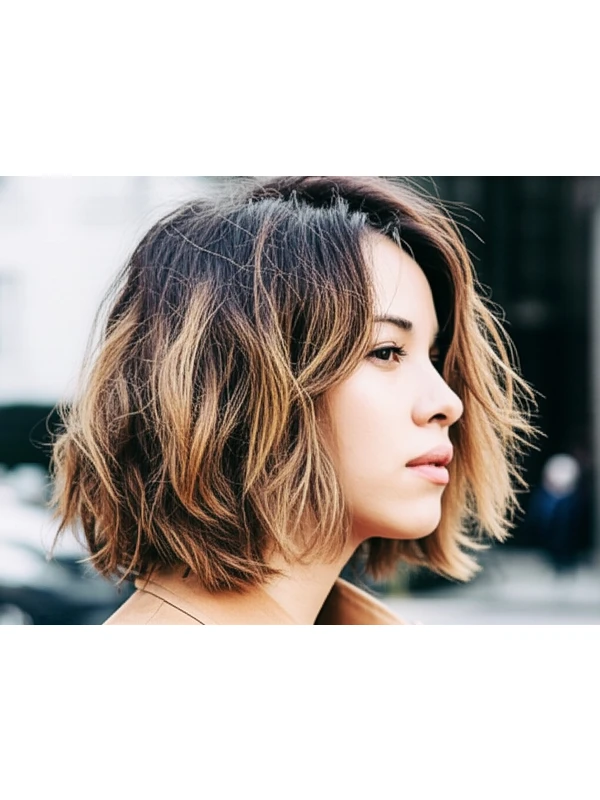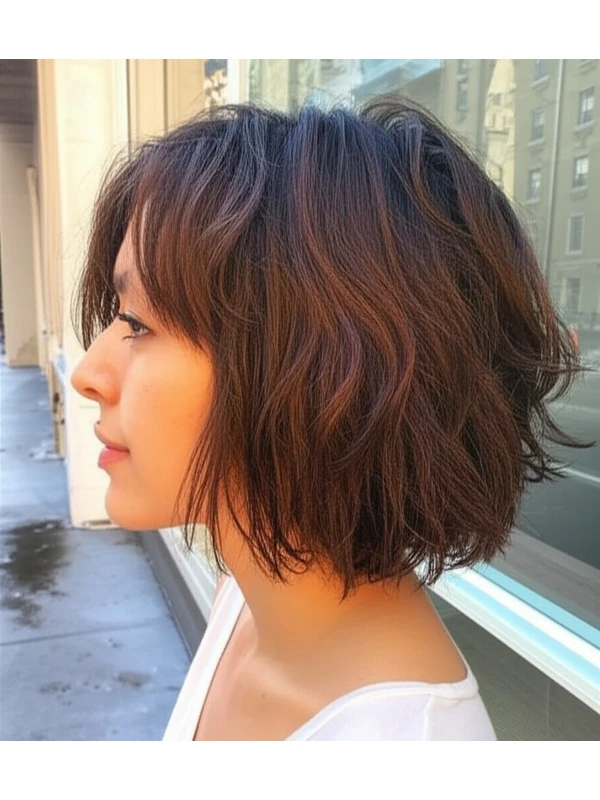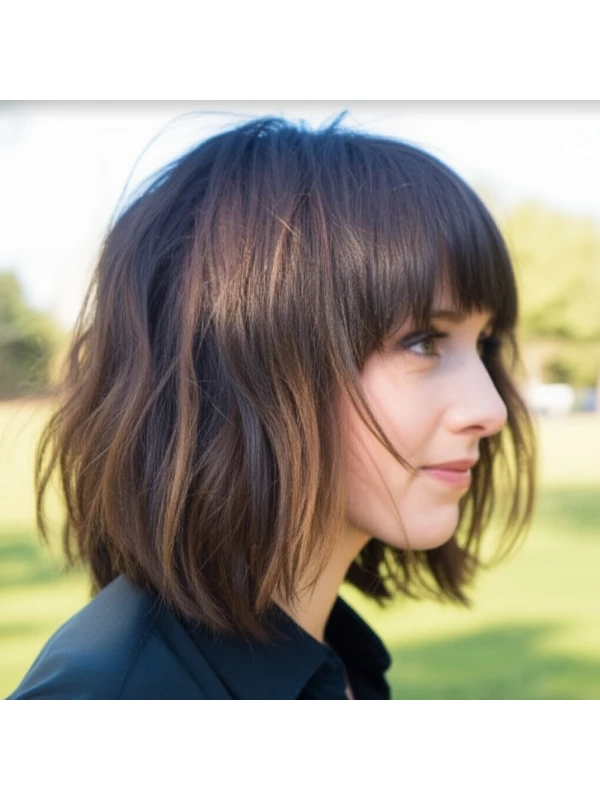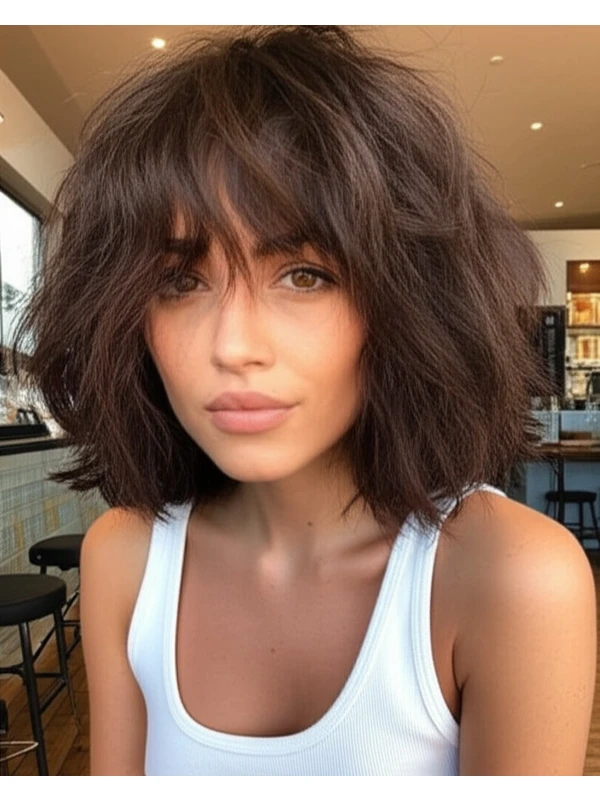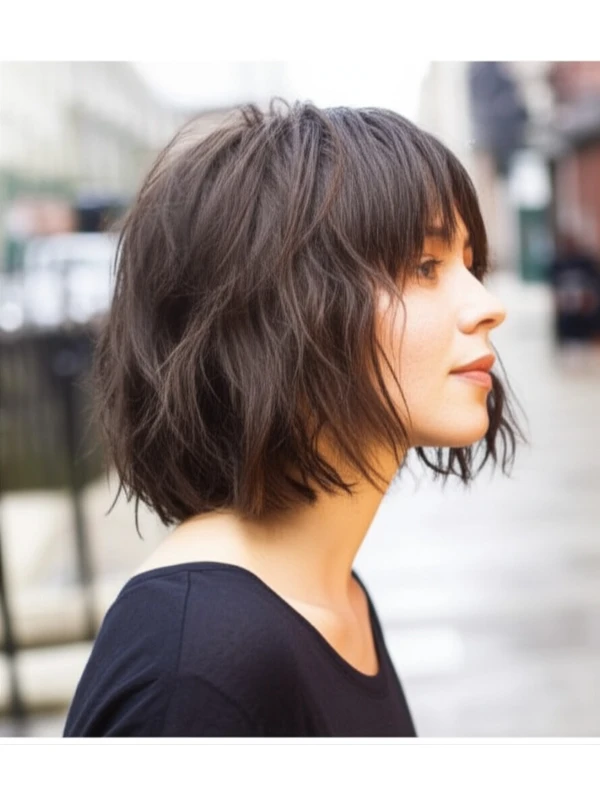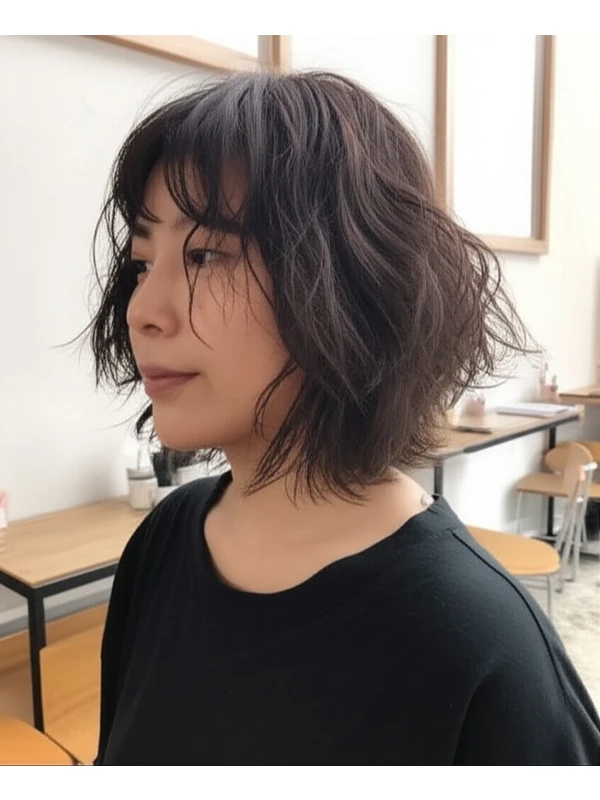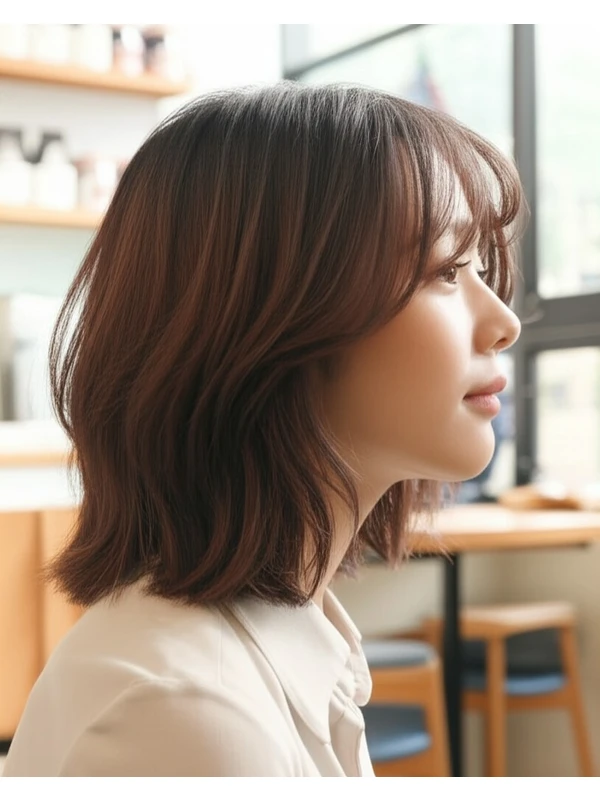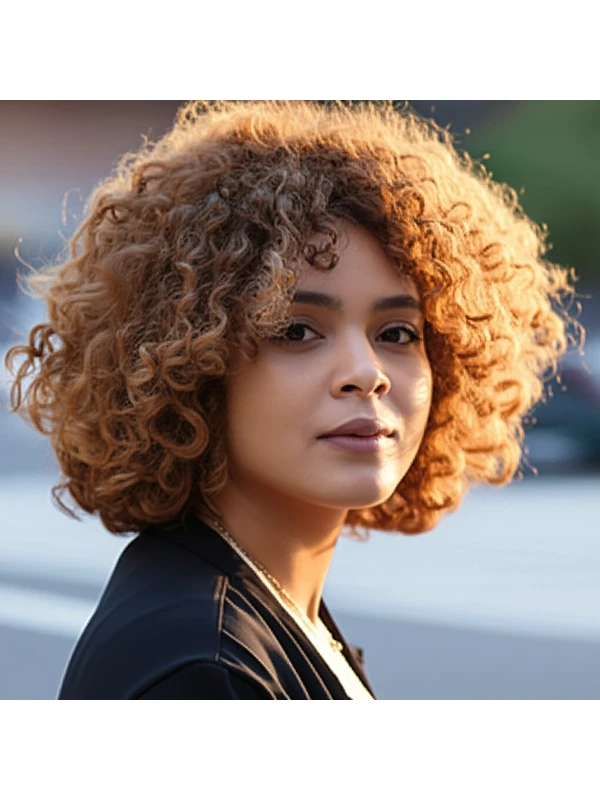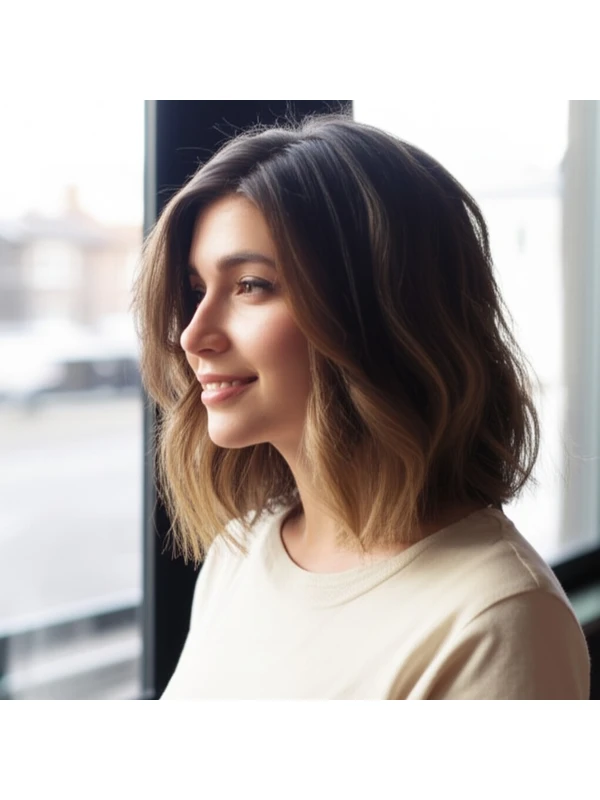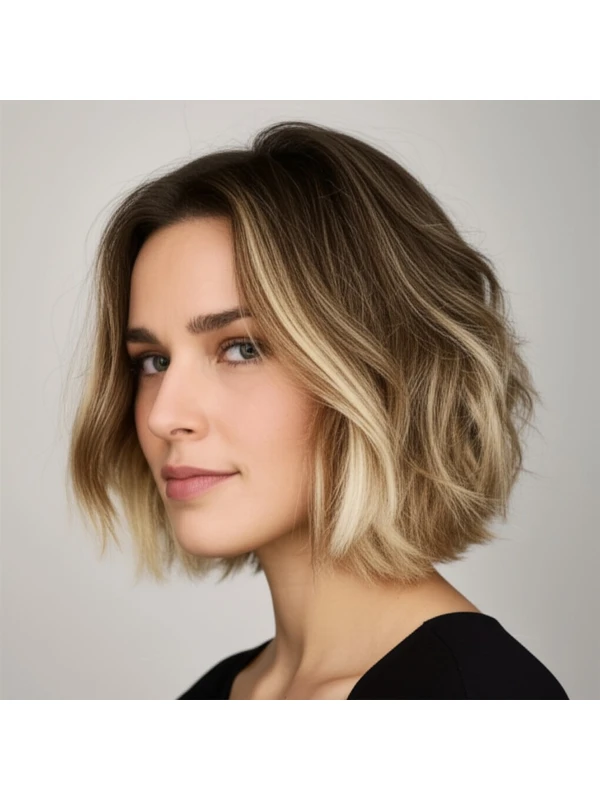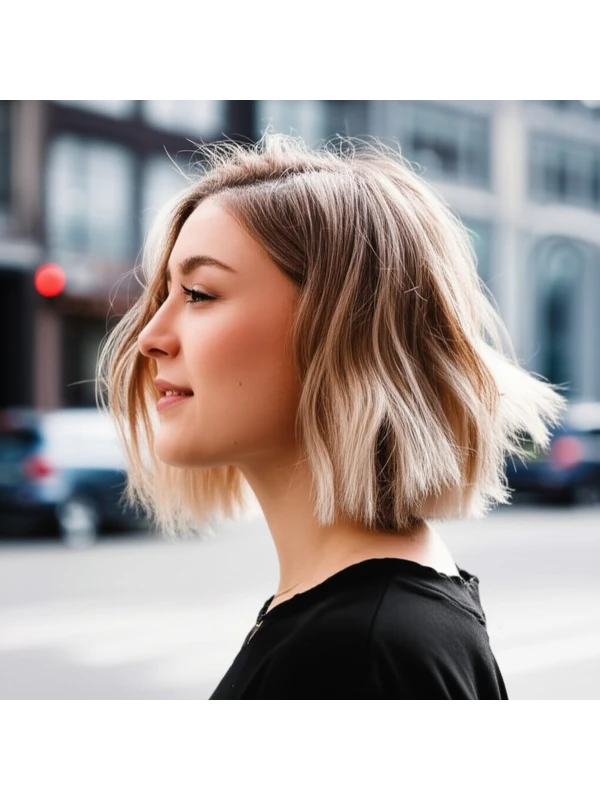#The Shaggy Lob: Your Guide to Effortless Cool
The shaggy lob is the haircut for anyone wanting a modern, low-maintenance look with plenty of personality. It’s versatile enough for almost everyone and can be adapted to suit various hair types and face shapes. Let's break down everything you need to know about this popular style.
#1) Background & Definition: What is a Shaggy Lob?
The "shaggy lob" (long bob) combines the flattering length of a long bob with layers that create texture, movement, and a deliberately undone feel. Think effortless cool – it looks like you woke up looking amazing!
- Cut Geometry: It’s typically cut longer than a traditional bob, usually falling between the collarbone and just past the shoulders. The key is the layers. These aren't blunt or uniform; they are intentionally choppy and uneven to create that shaggy texture.
- Key Features: Disconnected layers (meaning some are shorter, some longer), face-framing pieces, a softer perimeter (no harsh lines around the neck). It’s about movement and volume, not sleekness.
- Length Ranges: Generally 8–14 inches from the crown of your head. This can vary depending on hair texture – curly or coily hair will appear shorter due to shrinkage.
- Alternative Names: Textured lob, layered long bob, modern shag (though a true shag has even more dramatic layers).
#2) Face Shape Fit: Finding Your Best Angle
The shaggy lob is incredibly adaptable but understanding how it interacts with your face shape helps maximize its impact.
- Oval Faces: Lucky you! This cut looks fantastic on oval faces as the length and layers enhance natural symmetry. A side-swept fringe or curtain bangs work beautifully to soften features.
- Round Faces: The shaggy lob can slim a round face by adding vertical lines through the layers. Avoid too much volume at the cheeks; focus layering towards the ends. A longer, angled fringe (not blunt) helps elongate.
- Square Faces: Soften those angles! Layers around the jawline are crucial to diffuse sharpness. A side part and a wispy fringe can further soften features.
- Heart-Shaped Faces: The shaggy lob balances a wider forehead with its layers. Keep face-framing pieces long enough to reach the chin, softening the point of your chin. Side bangs work well.
- Diamond Faces: This cut highlights diamond faces' strong cheekbones and wide set eyes. Layers that start around the cheekbones are key. A fringe isn’t usually necessary but can be flattering if it is soft and wispy.
- Oblong (Long) Faces: The shaggy lob adds width, balancing a longer face shape. More volume at the sides and shorter layers near the chin will help create the illusion of broader features. Avoid excessive height on top.
#3) Body Proportions & Height Guidance: Tailoring to Your Silhouette
The shaggy lob isn't just about your face; it impacts how you appear overall!
- Petite: A shorter shaggy lob (8–10 inches) prevents the hair from overwhelming a smaller frame.
- Average Height: Most lengths work well, allowing for flexibility in styling and layering.
- Tall: A longer shaggy lob (12–14 inches) can help balance height.
- Narrow Shoulders: Layers that add volume at the shoulders create a more balanced silhouette.
- Broad Shoulders: Avoid excessive volume at the shoulder line; focus on layering to soften, not widen.
- Short Neck: Shorter layers around the face and jawline can help elongate the neck visually.
- Long Neck: A longer shaggy lob with more length in the back helps fill out a long neck.
#4) Works Best With Hair Types & Densities: Finding Your Perfect Match
The beauty of this cut is its adaptability, but certain hair types and densities benefit most.
- Straight Hair: Layers pop beautifully on straight hair, creating movement and texture.
- Wavy Hair: The shaggy lob enhances natural waves, adding definition and bounce.
- Curly/Coily Hair: This cut works well to remove bulk while maintaining curl pattern. Important: Account for shrinkage! What looks like a 12-inch lob when dry will be significantly shorter when wet. Communicate your desired length clearly with your stylist.
- Fine Hair: Layers add the illusion of volume, but avoid too many short layers which can make hair look sparse.
- Medium Hair: This is the "sweet spot" – the shaggy lob works incredibly well on medium-density hair.
- Thick Hair: Layers are essential to remove weight and create movement. A more dramatic layered approach will be needed for a lighter feel.
#5) Styling Variations: From Casual Cool to Evening Chic
The shaggy lob is a chameleon – it adapts to your mood!
- Sleek vs. Textured: Use smoothing serums for a sleeker look or texturizing sprays and sea salt mists for that signature "shag" vibe.
- Middle vs. Side Part: A side part adds asymmetry and can soften features, while a middle part creates balance.
- Fringe Variations: Curtain bangs (longer, face-framing), wispy bangs, or even no fringe at all!
- Occasion Styling: For work: blow dry with a round brush for subtle volume. For evenings: add waves with a curling wand and finish with hairspray.
#6) Maintenance: Keeping Your Shag Sharp
Regular trims are key to maintaining the shape of your shaggy lob.
- Trim Cadence: Every 6-8 weeks is standard, depending on how quickly your hair grows and how much shaping you want to maintain.
- At-Home Routine: Focus on moisturizing – layers can dry out easily!
- Heat vs. Air Dry: Air drying enhances the natural texture. If using heat, use a protectant spray always.
- Product Checklist: Shampoo & conditioner for your hair type, leave-in conditioner (especially important for textured hair), texturizing cream or mousse, finishing serum/oil.
- Estimated Daily Styling Time: 10–30 minutes, depending on desired style and texture.
#7) Grow-Out Roadmap: The Evolution of Your Style
The shaggy lob doesn't look the same throughout its grow-out phase.
- Months 1-3: The layers are most defined; shape is at its peak.
- Months 4-6: Layers start to blend, and the overall length elongates. Maintain face-framing pieces with a trim.
- Beyond 6 Months: The style transitions into more of an elongated shag – consider adjusting layering for continued movement.
#8) Color Pairings: Enhancing Your Cut's Dimension
Color can elevate your shaggy lob from good to gorgeous!
- Cool Undertones (pink, blue): Ashy blondes, cool browns, and even icy grays work beautifully.
- Warm Undertones (yellow, gold): Honey blondes, caramel highlights, copper tones are stunning choices.
- Low-Commitment Options: Balayage or babylights add dimension without a harsh root line. Face-framing money pieces brighten your complexion.
#9) Season & Occasion Guide: Styling for Every Moment
- Spring/Summer: Embrace the texture! Air dry with sea salt spray for effortless beachy vibes.
- Fall/Winter: Add warmth and dimension with richer tones and deeper layers.
- Work: Sleek, polished look with minimal styling.
- Weddings/Parties: Romantic waves or a more dramatic side-swept style.
- Formal Events: A sleek blow-out can elevate the shaggy lob for an elegant feel.
#10) Cost & Time: Salon Investment
- Salon Time: Typically 1–2 hours, depending on complexity and stylist expertise.
- Price Range: Expect to pay a moderate amount – more than a simple trim but less than a highly complex style.
#11) Pros & Cons: The Trade-Offs
Pros: Versatile, flattering for many face shapes, relatively low maintenance (with proper trims), modern and stylish. Cons: Requires regular trims to maintain shape, can look messy if not styled properly, layers can make fine hair appear thinner if done incorrectly.
#12) Salon Consultation Script: Your Questions Answered
Use these prompts when speaking with your stylist!
- "I'm interested in a shaggy lob. Can you show me some examples of what that would look like on my face shape?"
- “How many layers do you recommend based on my hair texture and density?”
- "What length would be most flattering for my features and body type?"
- "I'm not sure about a fringe. What are the options, and which one would complement my face?"
- "Can we discuss styling techniques that I can easily do at home to maintain this look?"
#FAQs: Your Burning Questions
- Will a shaggy lob work with my curly hair? Yes! But be sure to communicate your desired length carefully, accounting for shrinkage.
- How often do I need trims? Every 6-8 weeks is typical.
- Can I style it air dry? Absolutely! Air drying enhances the natural texture of a shaggy lob.
- Is this cut difficult to style? Not really! It’s designed for effortless cool, but some styling products will help achieve the desired look.
- Will layers make my fine hair look thinner? If too many short layers are added, yes. Discuss your concerns with your stylist beforehand.
- Can I add a fringe later if I'm not sure about it initially? Yes! It’s much easier to add a fringe than to remove one. Start with a soft, wispy option and see how you like it.
